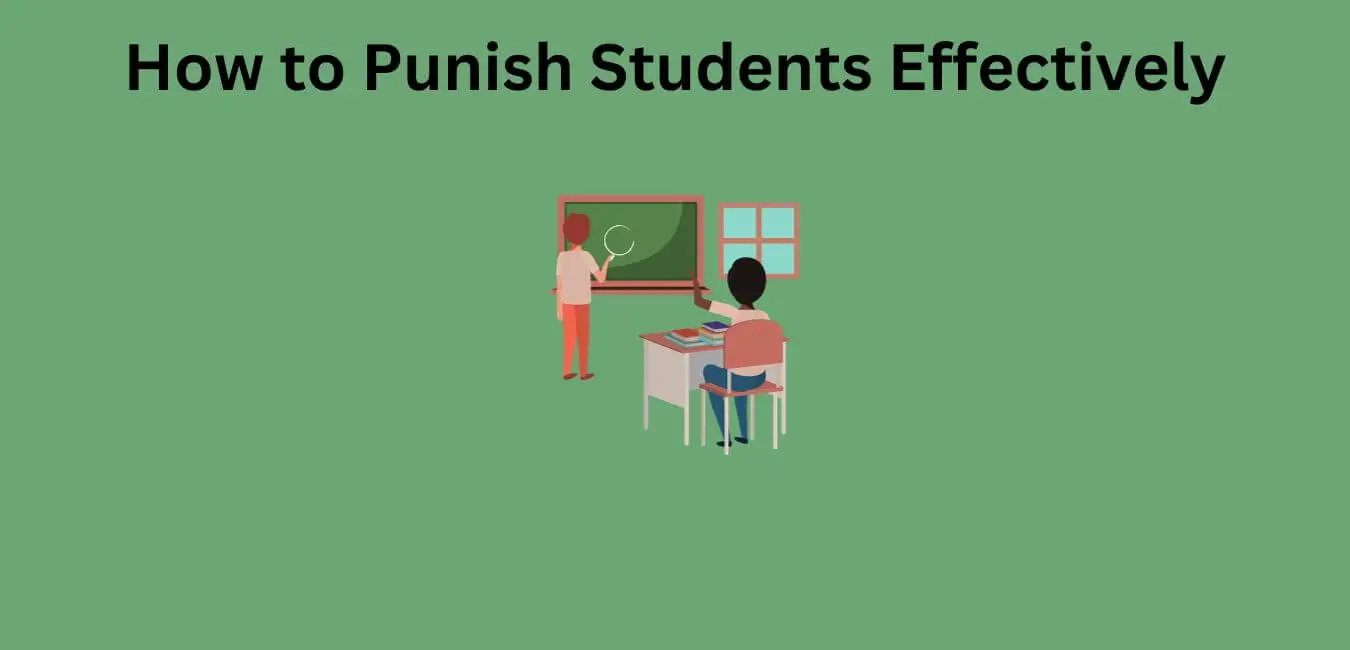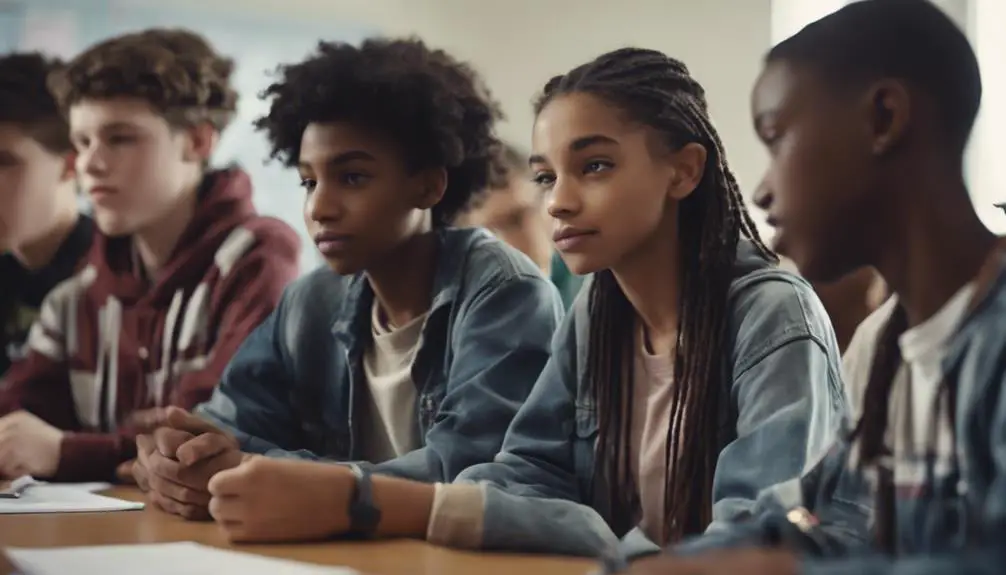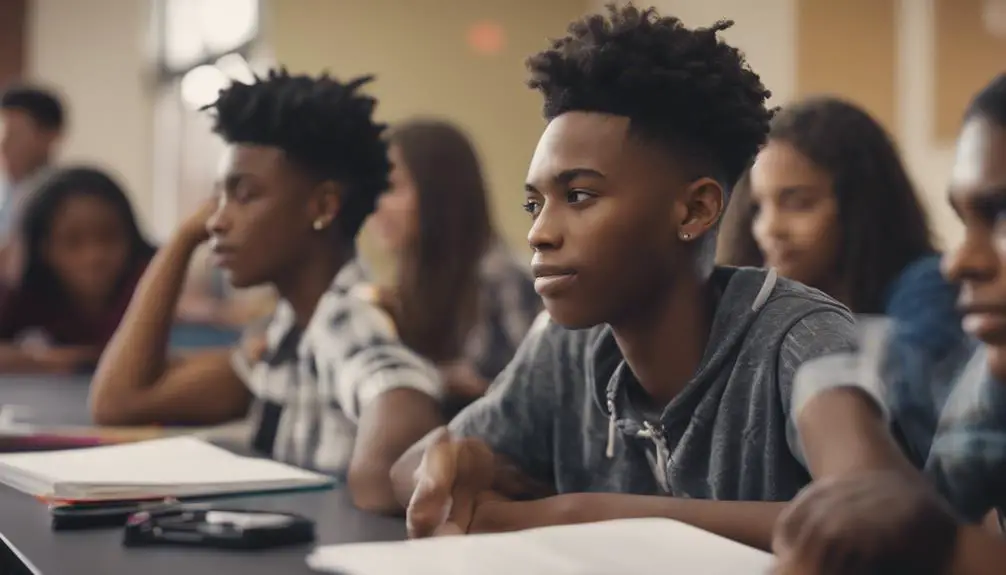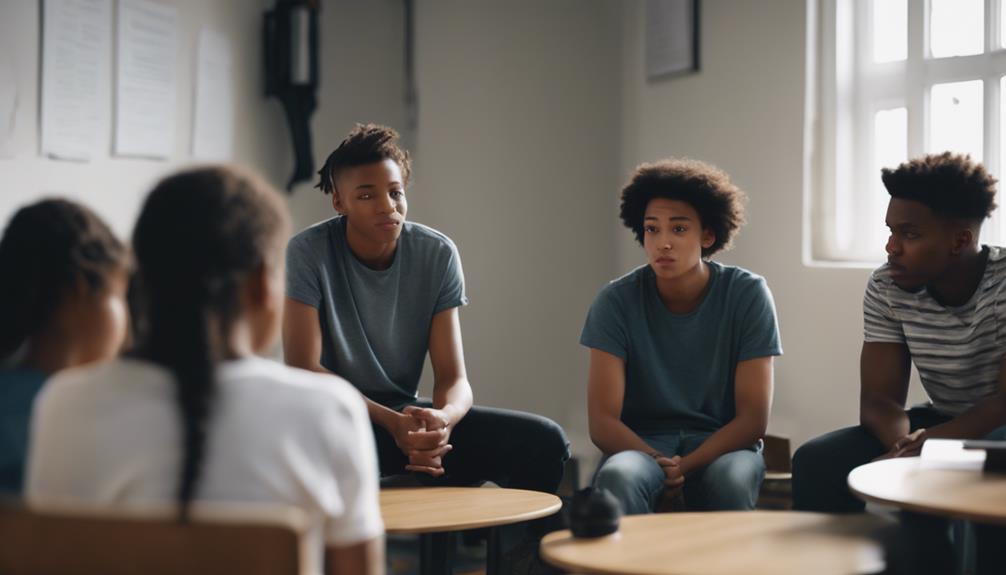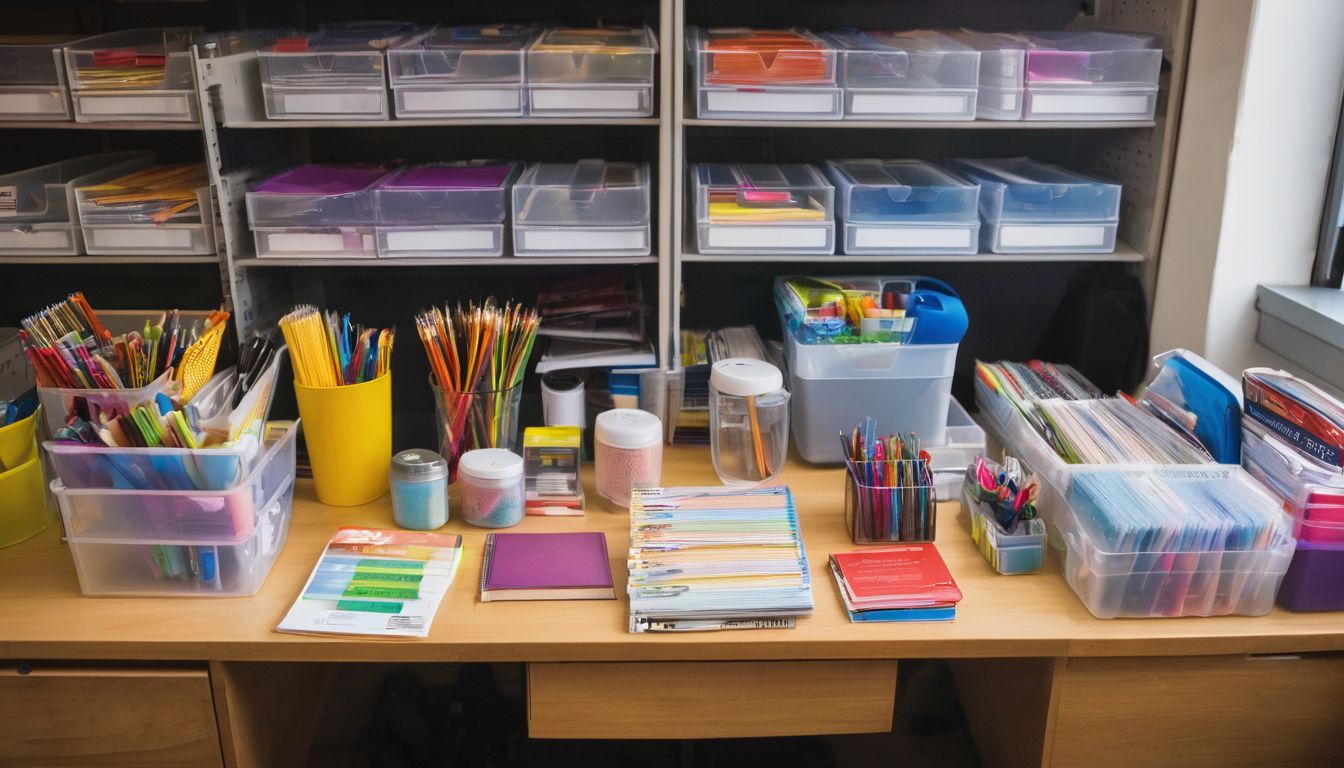
Navigating the turbulent seas of a noisy classroom can feel like quite the uphill battle, right? Trust me, you’re not alone in fighting this good fight. There’s resounding evidence that asserts strategic use of discipline can elevate learning and cultivate an atmosphere brimming with positivity.
This piece is here to equip you with practical tools for maintaining order and fostering respect in your learning environment. So let’s take a giant leap together into transforming our classrooms into hubs that seamlessly blend teaching and tranquility!
Key Takeaways
- Punishing students is important for teaching accountability, reinforcing boundaries, promoting a positive learning environment, and fostering respect for authority.
- Factors to consider when punishing students include consistency, proportionality, fairness, clarity of expectations, and individual needs and circumstances.
- Effective punishment strategies focus on teaching rather than humiliating or breaking down students.
- By implementing these approaches, teachers can create safe and inclusive environments that encourage positive behavior and growth in students.
Reasons for Punishing Students
Punishing students is important for teaching accountability, reinforcing boundaries, promoting a positive learning environment, teaching life skills, preventing negative behavior patterns, fostering respect for authority, and maintaining a safe and orderly classroom.
Teaching accountability
It’s important to show kids that their actions have results. Punishing wrong acts helps in this. For example, if a student talks during class time, they disrupt others’ learning. They need to know that such behavior won’t go unpunished.
This way, they learn how to see the link between how they act and what happens next. They’ll think more about what they do and make better choices in school and life as well. It’s not just for now, it helps them grow into responsible adults too.
Reinforcing boundaries
Reinforcing boundaries is an important aspect of disciplining students. When we consistently enforce rules and expectations, we teach them to respect authority and understand the limits of acceptable behavior.
By setting clear boundaries, we create a safe and orderly classroom environment where learning can flourish. It’s crucial to be fair in our disciplinary actions, considering factors such as the severity of the misbehavior and the age of the student.
Through consistent reinforcement, we help students learn responsibility and develop self-discipline skills that will serve them well in their lives.
Promoting a positive learning environment
Creating a positive learning environment is crucial for students to thrive and succeed. When students feel safe, supported, and respected in the classroom, they are more motivated to learn and behave appropriately.
One way to promote a positive learning environment is by setting clear expectations from the start. By clearly communicating what behaviors are expected and why they matter, students have a better understanding of how to act respectfully toward others.
Another important aspect of promoting a positive learning environment is building strong relationships with students. Taking the time to get to know your students individually shows them that you care about their well-being and success.
This can be done through conversations, one-on-one check-ins, or even simple gestures like greeting them at the door each morning.
In addition to setting expectations and building relationships, it’s essential to address any disruptions promptly but fairly. By addressing misbehavior swiftly and consistently, you teach students that there are consequences for their actions while also maintaining an orderly classroom environment.
Teaching life skills
Teaching life skills is an important aspect of disciplining students. When we punish students effectively, we have an opportunity to teach them valuable lessons that will benefit them throughout their lives.
By holding students accountable for their actions and providing consequences for misbehavior, we can help them learn how to make better choices in the future. This not only helps maintain a positive learning environment but also prepares students for the real world where they need to understand the importance of responsibility, respect, and self-discipline.
It’s our job as teachers to guide them and instill these vital life skills so that they can become responsible and successful individuals.
Preventing negative behavior patterns
In my experience as a teacher, one important reason for punishing students is to prevent negative behavior patterns. When we address misbehavior early on and provide appropriate consequences, we can help break down these negative patterns and teach students more positive ways to behave.
By consistently enforcing rules and expectations, we can show students what is acceptable and what is not. This helps create a safe and inclusive environment where everyone can focus on learning.
It’s important to remember that our goal should be teaching, rather than simply punishing, so that students have the opportunity to grow and develop better behavior habits.
Fostering respect for authority
Respect for authority is an important value to teach our students. When we punish them in a fair and consistent manner, it helps them understand that there are consequences for their actions.
It also shows them the importance of following rules and obeying authority figures. By fostering respect for authority through punishment, we are helping our students develop essential life skills that they will need as they grow older.
This includes being able to work well with others, respecting boundaries, and understanding the importance of order and structure in society. Through effective punishments, we can create a positive learning environment where everyone feels safe and respected.
Maintaining a safe and orderly classroom
Creating a safe and orderly classroom is crucial for effective teaching and learning. When students feel safe and secure, they are more likely to engage in positive behaviors and focus on their studies.
To maintain a safe and orderly classroom, it’s important to establish clear expectations from the beginning. Clearly communicate your rules and consequences so that students know what is expected of them.
Additionally, be consistent in enforcing these rules so that students understand that everyone will be held accountable for their actions. By creating a structured environment where everyone feels respected and supported, you can foster an atmosphere that promotes learning and growth.
Factors to Consider When Punishing Students
When considering how to effectively punish students, there are several important factors to keep in mind. Consistency, fairness, and clarity of expectations are crucial for maintaining a positive learning environment.
Tailoring punishments to individual needs and circumstances promotes accountability while also considering the well-being of each student. A restorative approach that focuses on teaching life skills and fostering respect for authority can be more beneficial than punitive measures alone.
Positive reinforcement should also be incorporated alongside punishment to encourage growth and behavioral change. By carefully considering these factors, teachers can create a disciplinary approach that is effective and supportive for their students’ development.
Read more about effective punishment strategies in my blog post!
Consistency
Consistency is a crucial factor to consider when punishing students. It means applying the same consequences for similar misbehavior consistently across all students. By being consistent, I can show my students that rules and expectations are fair and predictable.
This helps them understand the consequences of their actions and encourages them to make better choices in the future. Consistency also promotes a sense of fairness among my students, as they see that everyone is treated equally for their behavior.
It creates a safe and orderly classroom environment where everyone knows what is expected of them. Being consistent in my disciplined approach will help me effectively teach accountability and maintain a positive learning atmosphere for my students.
Proportionality
When it comes to punishing students, one important factor to consider is proportionality. This means that the punishment should match the severity of the misbehavior. It’s not fair or effective to give an overly harsh punishment for a minor offense.
On the other hand, a serious infraction may require a more substantial consequence.
Proportionality is crucial because it helps students understand the connection between their actions and the consequences they face. When punishments are proportional, they provide a clear message about what behavior is acceptable and what isn’t.
It also ensures that students feel treated fairly and reduces the likelihood of resentment or rebellion.
By considering proportionality in our approach to discipline, we can create a more positive learning environment where students have a better understanding of boundaries and expectations.
Fairness
Fairness is a crucial factor to consider when punishing students. It means treating all students equally and giving them a fair chance to learn from their mistakes. When we punish students, it’s important to ensure that the consequences are consistent and proportionate to the misbehavior.
This helps create a sense of fairness in the classroom and teaches students about accountability.
Punishments should also be clear and aligned with our expectations as teachers. By being clear about what behaviors are acceptable and unacceptable, we can help guide students toward making better choices.
Additionally, it’s important to take into account individual needs and circumstances when administering punishments. Every student is different, so tailoring the consequences based on their unique situations can help promote fairness.
When punishments are fair, they have a greater impact on shaping student behavior in positive ways. Students feel respected and understood when they know that disciplinary actions are administered fairly.
Clarity of expectations
It’s important to be clear about what you expect from your students. When they know exactly what is expected of them, it becomes easier for them to meet those expectations. Clear expectations help reduce confusion and misinterpretation, making it easier for students to understand the consequences of their actions.
By setting clear guidelines and communicating them effectively, you can create a structured learning environment where students have a better understanding of how their behavior will be addressed.
This promotes accountability and allows students to take responsibility for their actions.
Individual needs and circumstances
Every student is unique and has different needs and circumstances. When it comes to punishing students, it’s crucial to take these individual factors into account. Some students may have learning disabilities or mental health problems that affect their behavior.
Others may come from challenging backgrounds that require extra support and understanding. By considering the individual needs and circumstances of each student, we can tailor our disciplinary approach to better address their specific challenges and help them learn from their mistakes.
This personalized approach promotes fairness, empathy, and a positive relationship between teachers and students.
Restorative approaches
Restorative approaches are an important factor to consider when punishing students. Instead of focusing solely on punishment, restorative approaches aim to repair harm and restore relationships.
This involves bringing the person who has been harmed and the person responsible for the harm together to have a conversation. The goal is to encourage empathy, understanding, and accountability.
Restorative approaches can help students learn from their mistakes and find solutions that benefit everyone involved. It promotes a more positive and supportive learning environment where students can grow and develop their social skills.
Positive reinforcement
Positive reinforcement is an effective way to encourage good behavior and motivate students. By praising and rewarding students when they behave well or meet expectations, we can reinforce positive behaviors and create a more positive learning environment.
This helps students feel valued and appreciated, which in turn increases their engagement and motivation to continue behaving appropriately. Positive reinforcement can take many forms, such as verbal praise, stickers, tokens, or small rewards like extra free time or privileges.
It’s important to be specific in our praise so that students understand exactly what they are being recognized for. When used consistently and appropriately, positive reinforcement can foster a positive classroom climate where students feel supported and encouraged to do their best.
Effective Punishment Strategies
Effective punishment strategies can include implementing time-outs, loss of privileges, extra assignments, detention, reflection or apology letters, and community service. These strategies help students understand the consequences of their behavior and encourage them to reflect on their actions.
Time-outs
Time-outs are a common and effective punishment strategy that can help students reflect on their behavior. When a student misbehaves or disrupts the classroom, a time-out gives them a chance to take a break and calm down.
During this time, they should be separated from the rest of the class and given an opportunity to think about what they did wrong and how they can make better choices in the future.
Time-outs should be short, around five minutes for younger children and up to 15 minutes for older ones. It’s important to remember that time-outs should not be used as a way to humiliate or belittle students, but rather as a tool for teaching them appropriate behavior.
Loss of privileges
When students misbehave, one effective punishment strategy is to take away their privileges. This can be a powerful consequence because it shows them that their actions have consequences and teaches them about accountability.
By removing something they enjoy or value, like using electronic devices or participating in extracurricular activities, students learn the importance of following rules and behaving appropriately.
It also helps reinforce boundaries and maintain a safe and orderly classroom environment.
Taking away privileges should be done in a fair and consistent manner, considering factors such as the severity of the misbehavior and the age of the student. It’s important to clearly communicate expectations so that students understand why their privileges are being revoked.
Extra assignments
Extra assignments can be an effective punishment strategy for students who misbehave. By assigning additional work, teachers can provide a consequence that directly relates to the student’s behavior and helps them understand the impact of their actions.
It also gives students an opportunity to reflect on their choices and make amends by completing the extra assignments. However, it is important for teachers to ensure that the workload is appropriate and manageable for the student, considering factors such as their age, individual needs, and circumstances.
This approach promotes accountability, teaches responsibility, and encourages students to take ownership of their actions in a constructive way without resorting to humiliation or embarrassment.
Detention
Detention is a common punishment strategy used in schools to address student misbehavior. It involves keeping the student after school for a set period of time as a consequence of their actions.
The purpose of detention is to teach students responsibility and accountability for their behavior. By having them stay behind, it gives them an opportunity to reflect on what they did wrong and why it was not acceptable.
Detention can also serve as a deterrent, showing other students that there are consequences for breaking the rules. However, it’s important for teachers to ensure that detention is fair and proportionate to the infraction committed by the student.
Reflection or apology letters
When students misbehave, one effective punishment strategy is to have them write reflection or apology letters. This allows them to reflect on their actions and take responsibility for their behavior.
By writing these letters, they can express remorse, acknowledge the impact of their actions on others, and think about how they can make better choices in the future. Reflection or apology letters also provide an opportunity for teachers to communicate with students about the importance of empathy, understanding consequences, and learning from mistakes.
It helps promote self-awareness and personal growth while reinforcing positive behavior in a constructive way.
Community service
As teachers, one effective way to punish students is through community service. Community service allows students to learn the value of giving back and taking responsibility for their actions.
By engaging in activities that benefit others, such as volunteering at a local shelter or cleaning up a park, students can understand the impact of their behavior on the broader community.
Community service also provides an opportunity for students to develop empathy and compassion. Working alongside individuals from different backgrounds and circumstances helps them broaden their perspectives and appreciate the challenges faced by others.
It can teach them important life skills like teamwork, problem-solving, and communication.
Moreover, community service acts as a restorative approach where students have the chance to make amends for any harm they might have caused. Through meaningful engagement with their communities, they can reflect on their behavior and take steps toward positive change.
Ineffective Punishment Strategies
Ineffective punishment strategies can do more harm than good. Physical punishment, humiliation, and public shaming only serve to break down a student’s self-esteem and create further behavioral problems.
Discover more about the ineffective punishment strategies you should avoid using in your classroom by reading the full article!
Physical punishment
Physical punishment is not an effective way to discipline students. It can cause harm and have negative long-term effects on their well-being. Studies show that physical punishment, such as spanking or hitting, can lead to increased aggression, mental health problems, and decreased cognitive development in children.
Instead of resorting to physical punishment, it is important to find alternative strategies that focus on teaching appropriate behavior and promoting a positive learning environment.
These strategies may include time-outs, loss of privileges, or community service as consequences for misbehavior. By using non-physical punishments and addressing the underlying causes of misbehavior, we can create a safer and more inclusive classroom environment for all students.
Humiliation or embarrassment
Humiliating or embarrassing students as a form of punishment is not effective and can have harmful consequences. It can break down their self-esteem, hinder their learning, and create a negative school climate.
Research shows that harsh verbal discipline can lead to increased misbehavior and mental health problems in children. Instead of humiliation, it is important to focus on teaching appropriate behavior and helping students understand the consequences of their actions.
Punishments should be related to the specific infraction committed by the student, with an emphasis on teaching rather than shaming. Creating safe and inclusive environments where students feel respected is key to fostering positive behavior and growth.
Public shaming
Public shaming is not an effective strategy for disciplining students. It can be harmful and damaging to their self-esteem. Instead of using public shaming, it is important to find more constructive ways to address misbehavior and teach appropriate behavior.
Punishments should focus on teaching rather than humiliating or embarrassing the student.
Research has shown that public shaming can have negative effects on a student’s mental health and well-being. It can lead to increased misbehavior and even contribute to the development of mental health problems.
This approach does not create a safe and inclusive learning environment.
Instead, when dealing with misbehavior, it is important to consider individual needs and circumstances, as well as restorative approaches. This means finding ways for students to understand the impact of their actions, make amends if necessary, and learn from their mistakes in a supportive way.
Verbal abuse
Verbal abuse is not an effective way to punish students. When teachers use harsh and hurtful words, it can have serious negative effects on the student’s self-esteem and mental health.
Studies show that verbal discipline can actually lead to increased misbehavior and even contribute to mental health problems in children. Instead of using verbal abuse, it is important for teachers to find constructive ways to address misbehavior and teach appropriate behavior.
By focusing on positive reinforcement techniques, clear expectations, and open communication with students, we can create a safe and inclusive environment that promotes learning and growth.
Excessive or extended punishments
Excessive or extended punishments can be harmful to students and may not effectively teach them a lesson. It’s important to remember that the goal of punishment is to educate, not to break down or humiliate students.
When punishments are too severe or go on for too long, they can have negative impacts on a student’s mental health and overall well-being.
Research shows that harsh verbal discipline can actually lead to increased misbehavior and mental health problems in children. Instead of resorting to excessive punishments, it’s important for teachers to consider alternative strategies that focus on teaching appropriate behavior and helping students understand the consequences of their actions.
By using fair and proportionate punishments that are related to the specific infraction committed by the student, we can create safer and more inclusive learning environments. It’s also crucial for educators to consider individual needs and circumstances when implementing disciplinary measures.
This means taking into account factors such as the severity of the misbehavior, the age of the student, and how it might impact their learning and well-being.
Unrelated or disproportionate punishments
Sometimes, teachers may unintentionally give punishments that don’t match the misbehavior or are too severe. This can happen when we’re frustrated or overwhelmed with a student’s behavior.
However, it’s important to remember that unrelated or disproportionate punishments are not effective in teaching students and may even cause harm. For example, if a student forgets their homework once, giving them detention for a week would be unfair and discouraging.
Instead, punishments should be related to the specific misbehavior and aim to teach students appropriate behavior rather than just punishing them. We need to consider factors like the severity of the misbehavior, the age of the student, and how it might impact their learning and well-being before deciding on an appropriate punishment.
FAQs
1. What are some effective ways to punish students?
There are 19 methods for student discipline that can decrease misbehavior. This includes behavior management, classroom management techniques, and teaching through punishment.
2. Why might I need to punish my students if they misbehave?
You may need to consider consequences for student misbehavior to teach them about actions and effects. There are 11 reasons for this like helping build responsibility.
3. How should I deal with challenging teenagers?
Dealing with challenging teenagers needs effective student discipline strategies such as behavior modification methods and other approaches to student discipline that can help manage their actions.
4. What factors should be kept in mind while punishing students?
When using punishments, you must think about seven factors such as the impact of the punishment on their progress and the fairness of its application.
5. Can punishment also lead to learning outcomes?
Yes, sometimes teaching through punishment could lead to a change in behaviors among students if it is used right.
Conclusion
In conclusion, it is important to have effective strategies for punishing students when they misbehave. By teaching accountability, reinforcing boundaries, and promoting a positive learning environment, we can help them develop important life skills and respect for authority.
Factors such as consistency, fairness, and individual needs should be considered when applying punishments. Remember that punishment should focus on teaching rather than humiliating or breaking down the students.
With these approaches in mind, we can create safe and inclusive environments that encourage positive behavior and growth in our students.

